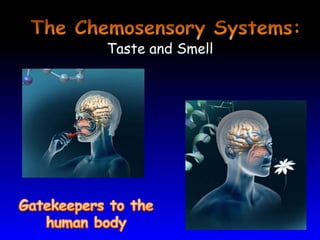Chemo senses
- 3. detect airborne chemicals detect chemicals dissolved in saliva Chemosenses provide survival value for animals
- 7. Some molecules can have same structures, but different Ą°smellsĄą Others can have different structures and be idĄŊd as same smell
- 8. 350 types of olfactory receptors, each sensitive to a particular group of odors. Each olfactory receptor neuron contains only 1 type of olfactory receptor.
- 10. Fatty, soapy Fatty, cheese,dairy Orange, rose, waxy Fatty, cheesy, waxy Almond
- 11. The functional grpasocc. w/ a compound (COOH for acids; OH for alcohols) determines the general area of the olfactory bulb that is activated, and the compounds length determines the position of the area.
- 12. Rats can distinguish betwn the 2 forms of Carvone, but not Limoene.
- 13. Others are more complex due to downstream processing.
- 16. Now add other odors, w/ their 100ĄŊs of molecules. We will not experience a jumbleĄhere weĄŊll smell coffee, bacon eggs!!!
- 17. Onion smell labeled pizza perceived more positively than one labeled body odor
- 18. Activity pattern in olfactory receptors the same. The label changed perception & this was reflected in different activity of secondary ctx.
- 21. ĻC All over, no taste buds ĻC Tip & sides fungiform ĻC Folds along back & sides folaite
- 22. ? Site of transduction ? Each receptor cell responds to a ltd # of molecule types. ? Receptors synapse w/ 3 cranial nerves ĻC These also carry non- taste info such as pain &tmp
- 24. ? Rat studies indicate some taste perception is based on distributed coding. ? Chemicals that produced similar firing patterns were perceived as the same (red & green lines)
- 26. ? Involves taste & olfaction ? Orbitofrontalctx combines taste, olfaction, primary somatosensory &what pathway ? Has neurons that respond to both taste & smell; others taste & vision ? Often respond to similar qualities (smell of sweet & taste of sweet)
- 29. ? A.L. Fox (worked for DuPont) prepped some PTC., co-worker c/o bitter taste from dustĄ.Fox tasted nothing. ? A.F Blaheslee ( a geneticist) dispensed PTC to 2500 Ss at a conference. ĻC 28%: Ą°tastelessĄą ĻC 66% Ą°bitterĄą
- 30. Why? ĻC Different # of receptors ĻC Some have specialized neurons
Editor's Notes
- Animals are able to detect chemical signals because they have Important evolutionary job ĻC keep genes in gene pool
- Emotional reaction happen firstSmell has a direct link to the amgdyla
- Dogs are better at smelling, ItĄŊs because they have a lot more olfactory receptors, not because theirs are better
- Olfactory neuron will only carry one olfactory kind of receptor
- Olfactory receptor neurons are located in nose, send axons to glomerulus in olfactory bulb (right under the brain)Receptors distributed all over
- Similar patterns of activity, then we perceive similar odorsDonĄŊt need to memorize the acids
- Highly organized further organized by the size of the molecules
- Red means lots of activityCool colors = less activityblack Arrows show that the activity is the sameWhite arrows show differences in activityRats can tell the different kind of carvone depending on the different activity of the neurons
- Neuron enters the olfactory bulb, goes to the piriform cortex, then gets bounced to the orbitofrontal cortex, then straight to the prefrontal areaThe olfactory senses are the only ones that donĄŊt stop at the thalamus
- This is why it takes a little longer for us to realize the emotional responseUsually, the olfactory was take the longer route
- Expectation alters perception of how favorable the smell was
- Subjects were told that it was either cheddar cheese or sweat, but it was actually both togetherChemical caused the exact same pattern of activity, the pattern of activity downstream was different depending on what they thought they were smelling
- Umami, sour, bitter, salt, sugar
- Know filiform, know that there are 4 forms of papillae
- TASTE budshave receptors that bind together and at the tips, transduce
- Area in the brain stem, first area information synapses
- Olfaction and taste are linked downstream such that perception of taste is heavily dependent on olfactory Smell influences taste
- There is a difference between the two group






























